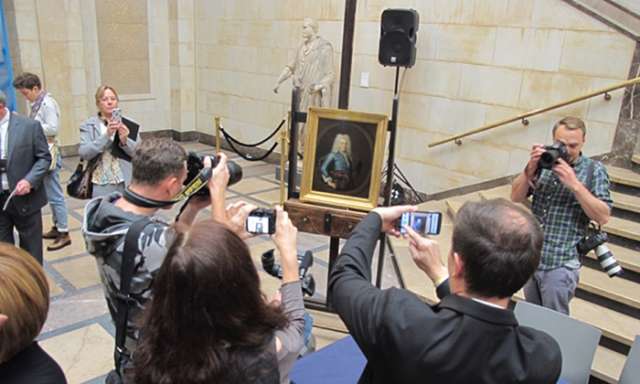Painting looted by Nazis makes triumphant return after decades

“People are looking at these objects every day without a second thought,” said Wittmann, 57, of the thousands of looted European artworks which have sat in American homes since the second world war. “They should question where they come from and give them back.”
The early Baroque portrait’s journey back to Poland began six years ago, when Wittmann, an engineer with General Motors in Detroit, began researching the war record of his builder father, John.
“I was only 12 when he passed away in 1971. I never had a chance to ask,” he said.
In a box of colour slides, Wittmann, 57, found an astonishing image, taken at home in Columbus. “It shows my dad, dressed in his 42nd infantry division uniform, holding a German Mauser gun to a bust of Hitler. I remembered the bust from home. We also had a German helmet with a bullet hole in it. The picture also shows other items my dad confiscated, or liberated, including a ceramic figure of a Prussian soldier, and the painting.”
After volunteering as a ranger and fighting in France, John Wittmann had been stationed at Bruck, Austria, close to Fischhorn Castle, the repository of Gestapo founder Hermann Göring’s plundered art.
“After the war, in August 1945, my dad wrote to his mother that there was a room full of jewels and another full of Rembrandts – though that may have been an exaggeration. He also wrote that he was trying to send a heavy box of objects home.”
Bob Wittmann realised the Lubieniecki may have been in the box when he found a slide of what appeared to be the back of the painting, with a number and a label marked Muzeum Narodowe w Warszawie (National Museum in Warsaw). In 2009 and 2010, he sent emails to the Polish embassy in Washington DC and contacted Homeland Security and the FBI.
But the trail went cold: “Even though I remembered the painting from my childhood, I had no idea where it was. My parents had divorced while I was still small. My father had remarried and I had no contact with my stepmother.”
He tracked down Carolyn Wittmann to Florida. But she had sold the painting “to a Mr Bobb” before relocating. It took the FBI until last month to find him – in Columbus, Ohio.
‘’I was out walking the dogs when the call came,’’ said retired food industrialist and art collector John Bobb III.
“The painting had been hanging in my dining room for 25 years. It is a very fine example of early Baroque, even though we do not know the identity of the man in the portrait,” said Bobb, 74, in Warsaw this week.
He will not disclose how much he paid for the work in 1990. He says the painting was not labelled when he bought it, but adds: “I had worried about its provenance. I did not hesitate for a moment to give it back to Poland.”
Indeed, Polish culture minister Małgorzata Omilanowska praised the “high ethics” that had led to the return of the painting “without a costly court case”. Her ministry has a database of more than 60,000 art objects that have been missing since the second world war.
Wittmann has conflicting feelings about the fact that his father lifted loot. But “it has become clear to me that the practice was common. After VE day, a lot disappeared. It was taken by locals and Americans. But it’s not too late to give it back.”
This article was amended on 13 October 2015. The original photo caption on the main image incorrectly referenced Bob Wittman.















































